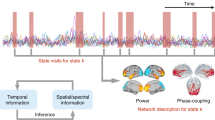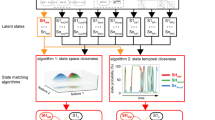Abstract
When the brain is in its noncognitive “idling” state, functional MRI measurements reveal the activation of default cortical networks whose activity is suppressed during cognitive processing. This default or background mode is characterized by ultra-slow BOLD oscillations (∼0.05 Hz), signaling extremely slow cycling in cortical metabolic demand across distinct cortical regions. Here we describe a model of the cortex which predicts that slow cycling of cortical activity can arise naturally as a result of nonlinear interactions between temporal (Hopf) and spatial (Turing) instabilities. The Hopf instability is triggered by delays in the inhibitory postsynaptic response, while the Turing instability is precipitated by increases in the strength of the gap-junction coupling between interneurons. We comment on possible implications for slow dendritic computation and information processing.
Similar content being viewed by others
References
Bennett, M. V., & Zukin, R. S. (2004). Electrical coupling and neuronal synchronization in the mammalian brain. Neuron, 41, 495–511.
Binder, J. R., Frost, J. A., Hammeke, T. A., Bellgowan, P. S. F., Rao, S. M., & Cox, R. W. (1999). Conceptual processing during the conscious resting state: a functional MRI study. J. Cogn. Neurosci., 11(1), 80–93.
Bose, S., Rodin, P., & Schöll, E. (2000). Competing spatial and temporal instabilities in a globally coupled bistable semiconductor systems near a codimension-two bifurcation. Phys. Rev. E, 62, 1778–1789.
Damoiseaux, J. S., Rombouts, S. A. R. B., Barkhof, F., Scheltens, P., Stam, C. J., Smith, S. M., & Beckmann, C. F. (2006). Consistent resting-state networks across healthy subjects. Proc. Natl. Acad. Sci. USA, 103, 13848–13853.
De Wit, A., Lima, D., Dewel, G., & Borckmans, P. (1996). Spatiotemporal dynamics near a codimension-two point. Phys. Rev. E, 54, 261–271.
Deco, G., Jirsa, V., McIntosh, A. R., Sporns, O., & Kötter, R. (2009). Key role of coupling, delay, and noise in resting brain fluctuations. Proc. Natl. Acad. Sci. USA, 106(25), 10302–10307.
Engel, A. K., Fries, P., & Singer, W. (2001). Dynamic predictions: Oscillations and synchrony in top-down processing. Nature Rev. Neurosci., 2(10), 704–716.
Fox, M. D., & Raichle, M. E. (2007). Spontaneous fluctuations in brain activity observed with functional magnetic resonance imaging. Nature Rev. Neurosci., 8, 700–711.
Fox, M. D., Snyder, A. Z., Vincent, J. L., Corbetta, M., van Essen, D. C., & Raichle, M. E. (2005). The human brain is intrinsically organized into dynamic, anticorrelated functional networks. Proc. Natl. Acad. Sci. USA, 102(27), 9673–9678.
Fransson, P. (2005). Human spontaneous low-frequency BOLD signal fluctuations: An fMRI investigation of the resting-state default mode of brain function hypothesis. Hum. Brain Mapp., 26, 15–29.
Fransson, P. (2006). How default is the default mode of brain function? Further evidence from intrinsic BOLD signal fluctuations. Neuropsychologia, 44(14), 2836–2845.
Fries, P. (2005). A mechanism for cognitive dynamics: Neuronal communication through neuronal coherence. Trends Cogn. Sci., 9(10), 474–480.
Ghosh, A., Rho, Y., McIntosh, A. R., Kötter, R., & Jirsa, V. K. (2008). Noise during rest enables the exploration of the brain’s dynamic repertoire. PLoS Comput. Biol., 4(10), e1000196.
Greicius, M. D., Krasnow, B., Reiss, A. L., & Menon, V. (2003). Functional connectivity in the resting brain: A network analysis of the default mode hypothesis. Proc. Natl. Acad. Sci. USA, 100, 253–258.
Gusnard, D. A., & Raichle, M. E. (2001). Searching for a baseline: Functional imaging and the resting human brain. Nature Rev. Neurosci., 2, 685–694.
Hagedorn, P., & DasGupta, A. (2007). Vibrations and waves in continuous mechanical systems. New York: Wiley.
Hagmann, P., Cammoun, L., Gigandet, X., Meuli, R., Honey, C. J., Wedeen, V. J., & Sporns, O. (2008). Mapping the structural core of human cerebral cortex. PLoS Biol., 6(7), e159.
Haüsser, M. (2001). Synaptic function: Dendritic democracy. Current Biol., 11(1), R10–R12.
Hlinka, J., & Coombes, S. (2010). Depolarization induced suppression of excitation and the emergence of ultraslow rhythms in neural networks. Phys. Rev. Lett., 104(6), 068101.
Honey, C. J., Kötter, R., Breakspear, M., & Sporns, O. (2007). Network structure of cerebral cortex shapes functional connectivity on multiple time scales. Proc. Natl. Acad. Sci. USA, 104(24), 10240–10245.
Kötter, R. (2004). Online retrieval, processing, and visualization of primate connectivity data from the CoCoMac database. Neuroinformatics, 2(2), 127–144.
Laufs, H., Kleinschmidt, A., Beyerle, A., Eger, E., Salek-Haddadi, A., Preibisch, C., & Krakow, K. (2003). EEG-correlated fMRI of human alpha activity. NeuroImage, 19(4), 1463–1476.
Mantini, D., Perrucci, M. G., Del Gratta, C., Romani, G. L., & Corbetta, M. (2007). Electrophysiological signatures of resting state networks in the human brain. Proc. Natl. Acad. Sci. USA, 104(32), 13170–13175.
Mazoyera, B., Zagoa, L., Melleta, E., Bricognea, S., Etarda, O., Houdéa, O., Crivelloa, F., Joliota, M., Petita, L., & Tzourio-Mazoyer, N. (2001). Cortical networks for working memory and executive functions sustain the conscious resting state in man. Brain Res. Bull., 54(3), 287–298.
Meixner, M., Bose, S., & Schöll, E. (1997a). Analysis of complex and chaotic patterns near a codimension-two Turing–Hopf point in a reaction–diffusion model. Physica D, 109, 128–138.
Meixner, M., De Wit, A., Bose, S., & Schöll, E. (1997b). Generic spatiotemporal dynamics near codimension-two Turing–Hopf bifurcations. Phys. Rev. E, 55, 6690–6697.
Migliore, M., & Shepherd, G. M. (2002). Emerging rules for the distributions of active dendritic conductances. Nature Rev. Neurosci., 3(5), 362–370.
Raichle, M. E., MacLeod, A. M., Snyder, A. Z., Powers, W. J., Gusnard, D. A., & Shulman, G. L. (2001). A default mode of brain function. Proc. Natl. Acad. Sci. USA, 98, 676–682.
Raichle, M. E., & Snyder, A. Z. (2007). A default mode of brain function: a brief history of an evolving idea. NeuroImage, 37(4), 1083–1090.
Rennie, C. J., Wright, J. J., & Robinson, P. A. (2000). Mechanisms for cortical electrical activity and emergence of gamma rhythm. J. Theor. Biol., 205, 17–35.
Robinson, P. A., Rennie, C. J., & Wright, J. J. (1997). Propagation and stability of waves of electrical activity in the cerebral cortex. Phys. Rev. E, 56, 826–840.
Segev, I., & London, M. (2000). Untangling dendrites with quantitative models. Science, 290(5492), 744–750.
Sporns, O., Honey, C. J., & Kötter, R. (2007). Identification and classification of hubs in brain networks. PLoS One, 2(10), e1049.
Steyn-Ross, D. A., Steyn-Ross, M. L., Wilson, M. T., & Sleigh, J. W. (2006). White-noise susceptibility and critical slowing in neurons near spiking threshold. Phys. Rev. E, 74, 051920.
Steyn-Ross, M. L., Steyn-Ross, D. A., Wilson, M. T., & Sleigh, J. W. (2007). Gap junctions mediate large-scale Turing structures in a mean-field cortex driven by subcortical noise. Phys. Rev. E, 76, 011916.
Steyn-Ross, M. L., Steyn-Ross, D. A., Wilson, M. T., & Sleigh, J. W. (2008). Interacting Turing and Hopf instabilities drive pattern formation in a noise-driven model cortex. In R. Wang, F. Gu, & E. Shen (Eds.), Advances in cognitive neurodynamics ICCN 2007 (pp. 227–232). Berlin: Springer. Chap. 40.
Steyn-Ross, M. L., Steyn-Ross, D. A., Wilson, M. T., & Sleigh, J. W. (2009). Modeling brain activation patterns for the default and cognitive states. NeuroImage, 45, 298–311.
Steyn-Ross, M. L., Steyn-Ross, D. A., Wilson, M. T., & Sleigh, J. W. (2010). Cortical patterns and gamma genesis are modulated by reversal potentials and gap-junction diffusion. In D. A. Steyn-Ross, & M. L. Steyn-Ross (Eds.), Springer series in computational neuroscience : Vol. 4. Modeling phase transitions in the brain (pp. 271–299). Berlin: Springer. Chap. 12.
Wright, J. J. (2010). Phase transitions, cortical gamma, and the selection and read-out of information stored in synapses. In D. A. Steyn-Ross, & M. L. Steyn-Ross (Eds.), Springer series in computational neuroscience : Vol. 4. Modeling phase transitions in the brain (pp. 243–269). Berlin: Springer. Chap. 11.
Yang, L., Dolnik, M., Zhabotinsky, A. M., & Epstein, I. R. (2002). Pattern formation arising from interactions between Turing and wave instabilities. J. Chem. Phys., 117, 7259–7265.
Author information
Authors and Affiliations
Corresponding author
Additional information
Research supported by the Royal Society of New Zealand Marsden Fund, contract 07-UOW-037.
Rights and permissions
About this article
Cite this article
Steyn-Ross, M.L., Steyn-Ross, D.A., Sleigh, J.W. et al. A Mechanism for Ultra-Slow Oscillations in the Cortical Default Network. Bull Math Biol 73, 398–416 (2011). https://doi.org/10.1007/s11538-010-9565-9
Received:
Accepted:
Published:
Issue Date:
DOI: https://doi.org/10.1007/s11538-010-9565-9




